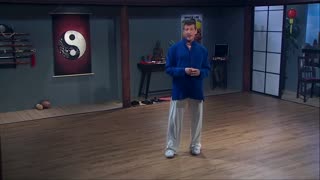Premium Only Content

21. Five Stages Of Mastery
In this lecture, we’ll be learning two new moves: snake creeps down (in a
new direction) and seven-stars posture. Those will get us most of the way
through our complete 40-movement sequence. The seven-stars posture in
particular is a difficult one, but doable. After we’ve covered those moves,
we’ll look at a concept known as the five stages of mastery in tai chi.
Snake Creeps Down
● Now it’s time for a new movement: to the opposite side from our
first snake creeps down.
● From the end of single whip, sit back, turn the waist to the right,
and circle the hands. The left hand goes upward and across the
chest. The right hand goes downward and outward, then upward.
● Bend the right leg to form a crouch step and turn the waist to the
left, raising the right hand up in a hook hand (shoulder high) as
you sink. Meanwhile, drop the left hand down past the ribs as you
sink, and along the inner side of the left leg with the palm facing
out, fingertips pointing to the east.
● Shift the weight onto the left foot to form a bow step. Raise the
left palm to shoulder level, while the hook hand drops behind your
back, fingers pointing up.
Shàng bù qī xīng (“Seven Stars Posture”)
● The next movement we’re going to learn is called shàng bù qī
xīng, which in English roughly means “seven stars posture.”
● Take a step forward with the right foot, ball on the floor to form an
empty step with the right foot. Form a loose fist with the left hand
sinking the elbow, withdrawing the arm slightly.
● Meanwhile, change the hook hand into another loose fist and
swing it forward and upward with the back of the hand turned
inward so the that the wrists cross at shoulder level, arms rounded.
Five Levels of Mastery
● Now that we’re most of the way through our 40-movement routine,
you’ve probably begun to feel changes in your ability level. Tai chi
has traditional levels of development.
○ The first level is where you can do the movements.
○ The second level is where you can do the movements
correctly—for instance, by linking them properly through breath.
○ The third level means you can do a good job at tai chi, creating
a high-quality routine.
○ The fourth level involves beginning to put your own stamp on
tai chi—creating a special quality in your routine.
○ The fifth level means your way of doing tai chi is totally unique:
Nobody could hope to copy you.
● The path of mastering tai chi is one of personal evolution. Your
own tai chi must continually evolve, just like the modern master
Bruce Lee evolves many martial arts into his own style.
-
 31:36
31:36
Mastering Tai Chi
1 year ago24. Another River To Cross
366 -
 LIVE
LIVE
TimcastIRL
58 minutes agoTrump Orders Specialized National Guard Units To Combat Crime In Cities, Dems Furious | Timcast IRL
22,479 watching -
 LIVE
LIVE
Barry Cunningham
2 hours agoPRESIDENT TRUMP MADE TODAY A VERY BAD DAY TO BE A DEMOCRAT!
6,445 watching -
 1:45:02
1:45:02
Glenn Greenwald
3 hours agoIsrael Slaughters More Journalists, Hiding War Crimes; Trump's Unconstitutional Flag Burning Ban; Glenn Takes Your Questions | SYSTEM UPDATE #504
68K43 -
 LIVE
LIVE
Stephen Gardner
35 minutes ago🔥'Burn ALL TRUMP FLAGS’ says Tim Walz + Democrat CAUGHT rigging own election!
442 watching -
 10:10
10:10
robbijan
1 day agoHollywood’s Hidden Messages: Predictive Programming & What’s Next
1.13K2 -
 LIVE
LIVE
SpartakusLIVE
2 hours ago#1 Rocket CHAMPION of Verdansk wields UNSTOPPABLE new META
281 watching -
 40:13
40:13
MattMorseTV
2 hours ago🔴It's EVEN WORSE than we thought...🔴
12K34 -
 LIVE
LIVE
The Jimmy Dore Show
2 hours agoSnoop Dogg Is DONE w/ LBGTQ+ Propaganda In Kids Movies! Trump Outlaws Burning the U.S. Flag!
7,374 watching -
 LIVE
LIVE
MissesMaam
4 hours agoDying Light w/ Da Bois💚✨
128 watching